Reversed HILIC Gradient: A Powerful Strategy for On-Line Comprehensive 2D-LC
Abstract
1. Introduction
2. Results and Discussion
2.1. Interest in revHILIC
2.1.1. Retention in HILIC and revHILIC
2.1.2. Measurement of LSS Parameters in RPLC, HILIC, and revHILIC
2.1.3. Assessing the Selectivity of revHILIC vs. RPLC and HILIC
2.1.4. Evaluation of Peak Shapes in revHILIC vs. RPLC and HILIC
2.1.5. Comparison of Orthogonality between RPLC, HILIC, and revHILIC
2.2. Applicability of revHILIC in Comprehensive 2D-LC
3. Materials and Methods
3.1. Chemicals and Reagents
3.2. Sample Preparation
3.3. Instrumentation
3.4. Analytical Methods
3.4.1. 1D-LC Methods
3.4.2. On-Line LC × LC Methods
4. Conclusions
Supplementary Materials
Author Contributions
Funding
Institutional Review Board Statement
Informed Consent Statement
Data Availability Statement
Conflicts of Interest
Sample Availability
References
- Alpert, A.J. Hydrophilic-Interaction Chromatography for the Separation of Peptides, Nucleic Acids and Other Polar Compounds. J. Chromatogr. A 1990, 499, 177–196. [Google Scholar] [CrossRef]
- McCalley, D.V. Understanding and Manipulating the Separation in Hydrophilic Interaction Liquid Chromatography. J. Chromatogr. A 2017, 1523, 49–71. [Google Scholar] [CrossRef] [PubMed]
- Hemström, P.; Irgum, K. Hydrophilic Interaction Chromatography. J. Sep. Sci. 2006, 29, 1784–1821. [Google Scholar] [CrossRef]
- Buszewski, B.; Noga, S. Hydrophilic Interaction Liquid Chromatography (HILIC)—A Powerful Separation Technique. Anal. Bioanal.Chem. 2012, 402, 231–247. [Google Scholar] [CrossRef]
- Jandera, P.; Janás, P. Recent Advances in Stationary Phases and Understanding of Retention in Hydrophilic Interaction Chromatography. A Review. Anal. Chim. Acta 2017, 967, 12–32. [Google Scholar] [CrossRef]
- McCalley, D.V.; Neue, U.D. Estimation of the Extent of the Water-Rich Layer Associated with the Silica Surface in Hydrophilic Interaction Chromatography. J. Chromatogr. A 2008, 1192, 225–229. [Google Scholar] [CrossRef] [PubMed]
- Bell, D.S. Retention and Selectivity of Stationary Phases Used in HILIC. LCGC N. Am. 2015, 33, 90–101. [Google Scholar]
- McCalley, D.V. A Study of the Analysis of Acidic Solutes by Hydrophilic Interaction Chromatography. J. Chromatogr. A 2018, 1534, 64–74. [Google Scholar] [CrossRef] [PubMed]
- Dong, L.; Huang, J. Effect of Temperature on the Chromatographic Behavior of Epirubicin and Its Analogues on High Purity Silica Using Reversed-Phase Solvents. Chromatographia 2007, 65, 519–526. [Google Scholar] [CrossRef]
- Bidlingmeyer, B.A.; Del Rios, J.K.; Korpi, J. Separation of Organic Amine Compounds on Silica Gel with Reversed-Phase Eluents. Anal. Chem. 1982, 54, 442–447. [Google Scholar] [CrossRef]
- Redón, L.; Subirats, X.; Rosés, M. Evaluation of Hold-Up Volume Determination Methods and Markers in Hydrophilic Interaction Liquid Chromatography. Molecules 2023, 28, 1372. [Google Scholar] [CrossRef] [PubMed]
- Dos Santos Pereira, A.; David, F.; Vanhoenacker, G.; Sandra, P. The Acetonitrile Shortage: Is Reversed HILIC with Water an Alternative for the Analysis of Highly Polar Ionizable Solutes? J. Sep. Sci. 2009, 32, 2001–2007. [Google Scholar] [CrossRef] [PubMed]
- Li, Y.; Li, J.; Chen, T.; Liu, X.; Zhang, H. Covalently Bonded Polysaccharide-Modified Stationary Phase for per Aqueous Liquid Chromatography and Hydrophilic Interaction Chromatography. J. Chromatogr. A 2011, 1218, 1503–1508. [Google Scholar] [CrossRef]
- Aboul-Enein, H.Y.; Rigi, G.; Farhadpour, M.; Ghasempour, A.; Ahmadian, G. Per Aqueous Liquid Chromatography (PALC) as a Simple Method for Native Separation of Protein A. Chromatographia 2017, 80, 1633–1639. [Google Scholar] [CrossRef]
- Redón, L.; Subirats, X.; Rosés, M. Volume and Composition of Semi-Adsorbed Stationary Phases in Hydrophilic Interaction Liquid Chromatography. Comparison of Water Adsorption in Common Stationary Phases and Eluents. J. Chromatogr. A 2021, 1656, 462543. [Google Scholar] [CrossRef] [PubMed]
- Chen, T.; Zhu, L.; Lu, H.; Song, G.; Li, Y.; Zhou, H.; Li, P.; Zhu, W.; Xu, H.; Shao, L. Preparation and Application of Covalently Bonded Polysaccharide-Modified Stationary Phase for per Aqueous Liquid Chromatography. Anal. Chim. Acta 2017, 964, 195–202. [Google Scholar] [CrossRef]
- Kumar, A.; Hart, J.P.; McCalley, D.V. Determination of Catecholamines in Urine Using Hydrophilic Interaction Chromatography with Electrochemical Detection. J. Chromatogr. A 2011, 1218, 3854–3861. [Google Scholar] [CrossRef]
- Gritti, F.; dos Santos Pereira, A.; Sandra, P.; Guiochon, G. Comparison of the Adsorption Mechanisms of Pyridine in Hydrophilic Interaction Chromatography and in Reversed-Phase Aqueous Liquid Chromatography. J. Chromatogr. A 2009, 1216, 8496–8504. [Google Scholar] [CrossRef]
- Gritti, F.; dos Santos Pereira, A.; Sandra, P.; Guiochon, G. Efficiency of the Same Neat Silica Column in Hydrophilic Interaction Chromatography and per Aqueous Liquid Chromatography. J. Chromatogr. A 2010, 1217, 683–688. [Google Scholar] [CrossRef]
- Matos, J.T.V.; Freire, S.M.S.C.; Duarte, R.M.B.O.; Duarte, A.C. Profiling Water-Soluble Organic Matter from Urban Aerosols Using Comprehensive Two-Dimensional Liquid Chromatography. Aerosol Sci. Technol. 2015, 49, 381–389. [Google Scholar] [CrossRef]
- Noga, S.; Felinger, A.; Buszewski, B. Hydrophilic Interaction Liquid Chromatography and Per Aqueous Liquid Chromatography in Fungicides Analysis. J. AOAC Int. 2012, 95, 1362–1370. [Google Scholar] [CrossRef]
- Orentienė, A.; Olšauskaitė, V.; Vičkačkaitė, V.; Padarauskas, A. Retention Behaviour of Imidazolium Ionic Liquid Cations on 1.7μm Ethylene Bridged Hybrid Silica Column Using Acetonitrile-Rich and Water-Rich Mobile Phases. J. Chromatogr. A 2011, 1218, 6884–6891. [Google Scholar] [CrossRef]
- Li, Y.; Xu, L.; Chen, T.; Liu, X.; Xu, Z.; Zhang, H. Carbon Nanoparticles from Corn Stalk Soot and Its Novel Application as Stationary Phase of Hydrophilic Interaction Chromatography and per Aqueous Liquid Chromatography. Anal. Chim. Acta 2012, 726, 102–108. [Google Scholar] [CrossRef]
- Pirok, B.W.J.; Stoll, D.R.; Schoenmakers, P.J. Recent Developments in Two-Dimensional Liquid Chromatography: Fundamental Improvements for Practical Applications. Anal. Chem. 2019, 91, 240–263. [Google Scholar] [CrossRef]
- Stoll, D.R.; Carr, P.W. Two-Dimensional Liquid Chromatography: A State of the Art Tutorial. Anal. Chem. 2017, 89, 519–531. [Google Scholar] [CrossRef] [PubMed]
- Vanhoenacker, G.; Vandenheede, I.; David, F.; Sandra, P.; Sandra, K. Comprehensive Two-Dimensional Liquid Chromatography of Therapeutic Monoclonal Antibody Digests. Anal. Bioanal.Chem. 2015, 407, 355–366. [Google Scholar] [CrossRef] [PubMed]
- Stoll, D.R.; Harmes, D.C.; Staples, G.O.; Potter, O.G.; Dammann, C.T.; Guillarme, D.; Beck, A. Development of Comprehensive Online Two-Dimensional Liquid Chromatography/Mass Spectrometry Using Hydrophilic Interaction and Reversed-Phase Separations for Rapid and Deep Profiling of Therapeutic Antibodies. Anal. Chem. 2018, 90, 5923–5929. [Google Scholar] [CrossRef]
- Iguiniz, M.; Corbel, E.; Roques, N.; Heinisch, S. Quantitative Aspects in On-Line Comprehensive Two-Dimensional Liquid Chromatography for Pharmaceutical Applications. Talanta 2019, 195, 272–280. [Google Scholar] [CrossRef]
- Sandra, K.; Steenbeke, M.; Vandenheede, I.; Vanhoenacker, G.; Sandra, P. The Versatility of Heart-Cutting and Comprehensive Two-Dimensional Liquid Chromatography in Monoclonal Antibody Clone Selection. J. Chromatogr. A 2017, 1523, 283–292. [Google Scholar] [CrossRef] [PubMed]
- Stoll, D.R.; Lhotka, H.R.; Harmes, D.C.; Madigan, B.; Hsiao, J.J.; Staples, G.O. High Resolution Two-Dimensional Liquid Chromatography Coupled with Mass Spectrometry for Robust and Sensitive Characterization of Therapeutic Antibodies at the Peptide Level. J. Chromatogr. B 2019, 1134–1135, 121832. [Google Scholar] [CrossRef]
- Ehkirch, A.; D’Atri, V.; Rouviere, F.; Hernandez-Alba, O.; Goyon, A.; Colas, O.; Sarrut, M.; Beck, A.; Guillarme, D.; Heinisch, S.; et al. An Online Four-Dimensional HIC×SEC-IM×MS Methodology for Proof-of-Concept Characterization of Antibody Drug Conjugates. Anal. Chem. 2018, 90, 1578–1586. [Google Scholar] [CrossRef]
- Montero, L.; Ibáñez, E.; Russo, M.; di Sanzo, R.; Rastrelli, L.; Piccinelli, A.L.; Celano, R.; Cifuentes, A.; Herrero, M. Metabolite Profiling of Licorice (Glycyrrhiza Glabra) from Different Locations Using Comprehensive Two-Dimensional Liquid Chromatography Coupled to Diode Array and Tandem Mass Spectrometry Detection. Anal. Chim. Acta 2016, 913, 145–159. [Google Scholar] [CrossRef]
- Montero, L.; Ibáñez, E.; Russo, M.; Rastrelli, L.; Cifuentes, A.; Herrero, M. Focusing and Non-Focusing Modulation Strategies for the Improvement of on-Line Two-Dimensional Hydrophilic Interaction Chromatography × Reversed Phase Profiling of Complex Food Samples. Anal. Chim. Acta 2017, 985, 202–212. [Google Scholar] [CrossRef]
- Sommella, E.; Pagano, F.; Salviati, E.; Chieppa, M.; Bertamino, A.; Manfra, M.; Sala, M.; Novellino, E.; Campiglia, P. Chemical Profiling of Bioactive Constituents in Hop Cones and Pellets Extracts by Online Comprehensive Two-Dimensional Liquid Chromatography with Tandem Mass Spectrometry and Direct Infusion Fourier Transform Ion Cyclotron Resonance Mass Spectrometry. J. Sep. Sci. 2018, 41, 1548–1557. [Google Scholar] [CrossRef] [PubMed]
- Arena, K.; Cacciola, F.; Dugo, L.; Dugo, P.; Mondello, L. Determination of the Metabolite Content of Brassica Juncea Cultivars Using Comprehensive Two-Dimensional Liquid Chromatography Coupled with a Photodiode Array and Mass Spectrometry Detection. Molecules 2020, 25, 1235. [Google Scholar] [CrossRef] [PubMed]
- Kalili, K.M.; Vestner, J.; Stander, M.A.; de Villiers, A. Toward Unraveling Grape Tannin Composition: Application of Online Hydrophilic Interaction Chromatography × Reversed-Phase Liquid Chromatography–Time-of-Flight Mass Spectrometry for Grape Seed Analysis. Anal. Chem. 2013, 85, 9107–9115. [Google Scholar] [CrossRef] [PubMed]
- Toro-Uribe, S.; Montero, L.; López-Giraldo, L.; Ibáñez, E.; Herrero, M. Characterization of Secondary Metabolites from Green Cocoa Beans Using Focusing-Modulated Comprehensive Two-Dimensional Liquid Chromatography Coupled to Tandem Mass Spectrometry. Anal. Chim. Acta 2018, 1036, 204–213. [Google Scholar] [CrossRef]
- Donato, P.; Giuffrida, D.; Oteri, M.; Inferrera, V.; Dugo, P.; Mondello, L. Supercritical Fluid Chromatography × Ultra-High Pressure Liquid Chromatography for Red Chilli Pepper Fingerprinting by Photodiode Array, Quadrupole-Time-of-Flight and Ion Mobility Mass Spectrometry (SFC × RP-UHPLC-PDA-Q-ToF MS-IMS). Food Anal. Methods 2018, 11, 3331–3341. [Google Scholar] [CrossRef]
- Van der Horst, A.; Schoenmakers, P.J. Comprehensive Two-Dimensional Liquid Chromatography of Polymers. J. Chromatogr. A 2003, 1000, 693–709. [Google Scholar] [CrossRef] [PubMed]
- Pursch, M.; Wegener, A.; Buckenmaier, S. Evaluation of Active Solvent Modulation to Enhance Two-Dimensional Liquid Chromatography for Target Analysis in Polymeric Matrices. J. Chromatogr. A 2018, 1562, 78–86. [Google Scholar] [CrossRef]
- Groeneveld, G.; Dunkle, M.N.; Rinken, M.; Gargano, A.F.G.; de Niet, A.; Pursch, M.; Mes, E.P.C.; Schoenmakers, P.J. Characterization of Complex Polyether Polyols Using Comprehensive Two-Dimensional Liquid Chromatography Hyphenated to High-Resolution Mass Spectrometry. J. Chromatogr. A 2018, 1569, 128–138. [Google Scholar] [CrossRef]
- Gilar, M.; Olivova, P.; Daly, A.E.; Gebler, J.C. Orthogonality of Separation in Two-Dimensional Liquid Chromatography. Anal. Chem. 2005, 77, 6426–6434. [Google Scholar] [CrossRef] [PubMed]
- Chapel, S.; Rouvière, F.; Heinisch, S. Pushing the Limits of Resolving Power and Analysis Time in On-Line Comprehensive Hydrophilic Interaction x Reversed Phase Liquid Chromatography for the Analysis of Complex Peptide Samples. J. Chromatogr. A 2020, 1615, 460753. [Google Scholar] [CrossRef] [PubMed]
- Ruta, J.; Rudaz, S.; McCalley, D.V.; Veuthey, J.-L.; Guillarme, D. A Systematic Investigation of the Effect of Sample Diluent on Peak Shape in Hydrophilic Interaction Liquid Chromatography. J. Chromatogr. A 2010, 1217, 8230–8240. [Google Scholar] [CrossRef]
- Chapel, S.; Heinisch, S. Strategies to Circumvent the Solvent Strength Mismatch Problem in Online Comprehensive Two-Dimensional Liquid Chromatography. J. Sep. Sci. 2022, 45, 7–26. [Google Scholar] [CrossRef] [PubMed]
- Chen, Y.; Montero, L.; Schmitz, O.J. Advance in On-Line Two-Dimensional Liquid Chromatography Modulation Technology. TrAC, Trends Anal. Chem. 2019, 120, 115647. [Google Scholar] [CrossRef]
- Česla, P.; Křenková, J. Fraction Transfer Process in On-Line Comprehensive Two-Dimensional Liquid-Phase Separations. J. Sep. Sci. 2017, 40, 109–123. [Google Scholar] [CrossRef]
- Grumbach, E.S.; Wagrowski-Diehl, D.M.; Mazzeo, J.R.; Alden, B.; Iraneta, P.C. Hydrophilic Interaction Chromatography Using Silica Columns for the Retention of Polar Analytes and Enhanced ESI-MS Sensitivity. LC-GC North America 2004, 22, 1010–1019. [Google Scholar]
- High-Performance Gradient Elution: The Practical Application of the Linear-Solvent-Strength Model. Available online: https://www.wiley.com/en-us/High+Performance+Gradient+Elution%3A+The+Practical+Application+of+the+Linear+Solvent+Strength+Model-p-9780471706465 (accessed on 9 March 2023).
- Heinisch, S.; Rocca, J.-L.; Feinberg, M. Optimization of a Chromatographic Analysis in Reversed Phase Liquid Chromatography. J. Chemom. 1989, 3, 127–137. [Google Scholar] [CrossRef]
- Fekete, S.; Lauber, M. Studying Effective Column Lengths in Liquid Chromatography of Large Biomolecules. J. Chromatogr. A 2023, 1692, 463848. [Google Scholar] [CrossRef]
- D’Attoma, A.; Grivel, C.; Heinisch, S. On-Line Comprehensive Two-Dimensional Separations of Charged Compounds Using Reversed-Phase High Performance Liquid Chromatography and Hydrophilic Interaction Chromatography. Part I: Orthogonality and Practical Peak Capacity Considerations. J. Chromatogr. A 2012, 1262, 148–159. [Google Scholar] [CrossRef]
- Al Bakain, R.; Rivals, I.; Sassiat, P.; Thiébaut, D.; Hennion, M.-C.; Euvrard, G.; Vial, J. Comparison of Different Statistical Approaches to Evaluate the Orthogonality of Chromatographic Separations: Application to Reverse Phase Systems. J. Chromatogr. A 2011, 1218, 2963–2975. [Google Scholar] [CrossRef] [PubMed]
- Gilar, M.; Fridrich, J.; Schure, M.R.; Jaworski, A. Comparison of Orthogonality Estimation Methods for the Two-Dimensional Separations of Peptides. Anal. Chem. 2012, 84, 8722–8732. [Google Scholar] [CrossRef] [PubMed]
- Sarrut, M.; D’Attoma, A.; Heinisch, S. Optimization of Conditions in On-Line Comprehensive Two-Dimensional Reversed Phase Liquid Chromatography. Experimental Comparison with One-Dimensional Reversed Phase Liquid Chromatography for the Separation of Peptides. J. Chromatogr. A 2015, 1421, 48–59. [Google Scholar] [CrossRef]
- Sarrut, M.; Rouvière, F.; Heinisch, S. Theoretical and Experimental Comparison of One Dimensional versus On-Line Comprehensive Two Dimensional Liquid Chromatography for Optimized Sub-Hour Separations of Complex Peptide Samples. J. Chromatogr. A 2017, 1498, 183–195. [Google Scholar] [CrossRef]
- D’Attoma, A.; Heinisch, S. On-Line Comprehensive Two Dimensional Separations of Charged Compounds Using Reversed-Phase High Performance Liquid Chromatography and Hydrophilic Interaction Chromatography. Part II: Application to the Separation of Peptides. J. Chromatogr. A 2013, 1306, 27–36. [Google Scholar] [CrossRef] [PubMed]
- Heinisch, S.; D’Attoma, A.; Grivel, C. Effect of PH Additive and Column Temperature on Kinetic Performance of Two Different Sub-2 μm Stationary Phases for Ultrafast Separation of Charged Analytes. J. Chromatogr. A 2012, 1228, 135–147. [Google Scholar] [CrossRef] [PubMed]
- Chapel, S.; Rouvière, F.; Heinisch, S. A Theoretical and Practical Approach to Manage High Peak Capacity and Low Dilution in On-Line Comprehensive Reversed-Phase LC × Reversed-Phase LC: A Comparison with 1D-Reversed-Phase LC. LC-GC Eur. 2020, 33, 17–26. [Google Scholar]
- Guillarme, D.; Rouvière, F.; Heinisch, S. Theoretical and Practical Comparison of RPLC and RPLC × RPLC: How to Consider Dilution Effects and Sensitivity in Addition to Separation Power? Anal. Bioanal.Chem. 2023, 415, 2357–2369. [Google Scholar] [CrossRef]
- Iguiniz, M.; Rouvière, F.; Corbel, E.; Roques, N.; Heinisch, S. Comprehensive Two Dimensional Liquid Chromatography as Analytical Strategy for Pharmaceutical Analysis. J. Chromatogr. A 2018, 1536, 195–204. [Google Scholar] [CrossRef]
- Rutan, S.C.; Davis, J.M.; Carr, P.W. Fractional Coverage Metrics Based on Ecological Home Range for Calculation of the Effective Peak Capacity in Comprehensive Two-Dimensional Separations. J. Chromatogr. A 2012, 1255, 267–276. [Google Scholar] [CrossRef]
- Davis, J.M. Dependence of Effective Peak Capacity in Comprehensive Two-Dimensional Separations on the Distribution of Peak Capacity between the Two Dimensions. Anal. Chem. 2008, 80, 8122–8134. [Google Scholar] [CrossRef]
- Davis, J.M.; Stoll, D.R.; Carr, P.W. Effect of First-Dimension Undersampling on Effective Peak Capacity in Comprehensive Two-Dimensional Separations. Anal. Chem. 2008, 80, 461–473. [Google Scholar] [CrossRef] [PubMed]
- Chapel, S.; Rouvière, F.; Heinisch, S. Comparison of Existing Strategies for Keeping Symmetrical Peaks in On-Line Hydrophilic Interaction Liquid Chromatography x Reversed-Phase Liquid Chromatography despite Solvent Strength Mismatch. J. Chromatogr. A 2021, 1642, 462001. [Google Scholar] [CrossRef] [PubMed]
- Chapel, S.; Rouvière, F.; Peppermans, V.; Desmet, G.; Heinisch, S. A Comprehensive Study on the Phenomenon of Total Breakthrough in Liquid Chromatography. J. Chromatogr. A 2021, 1653, 462399. [Google Scholar] [CrossRef] [PubMed]
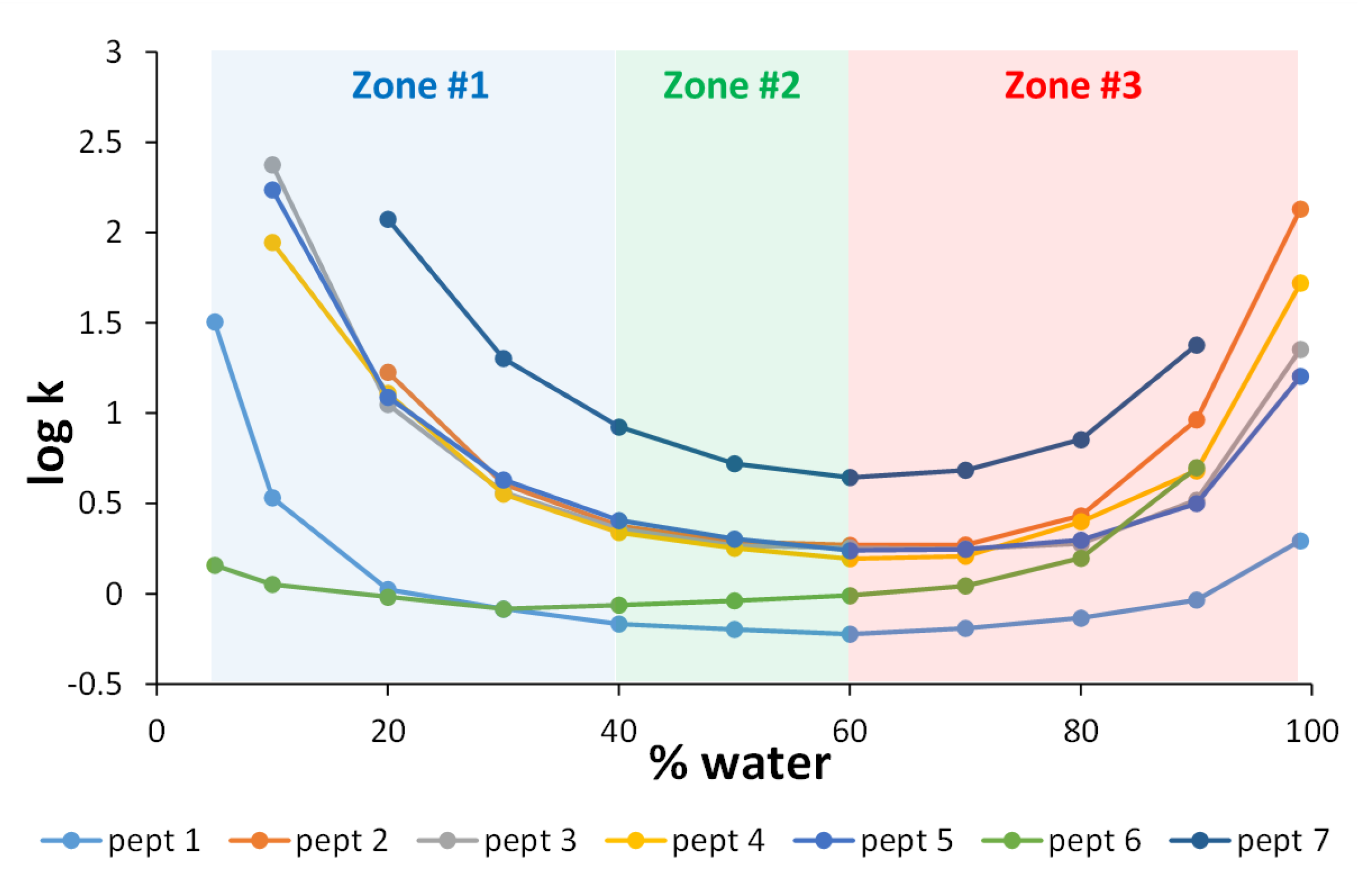
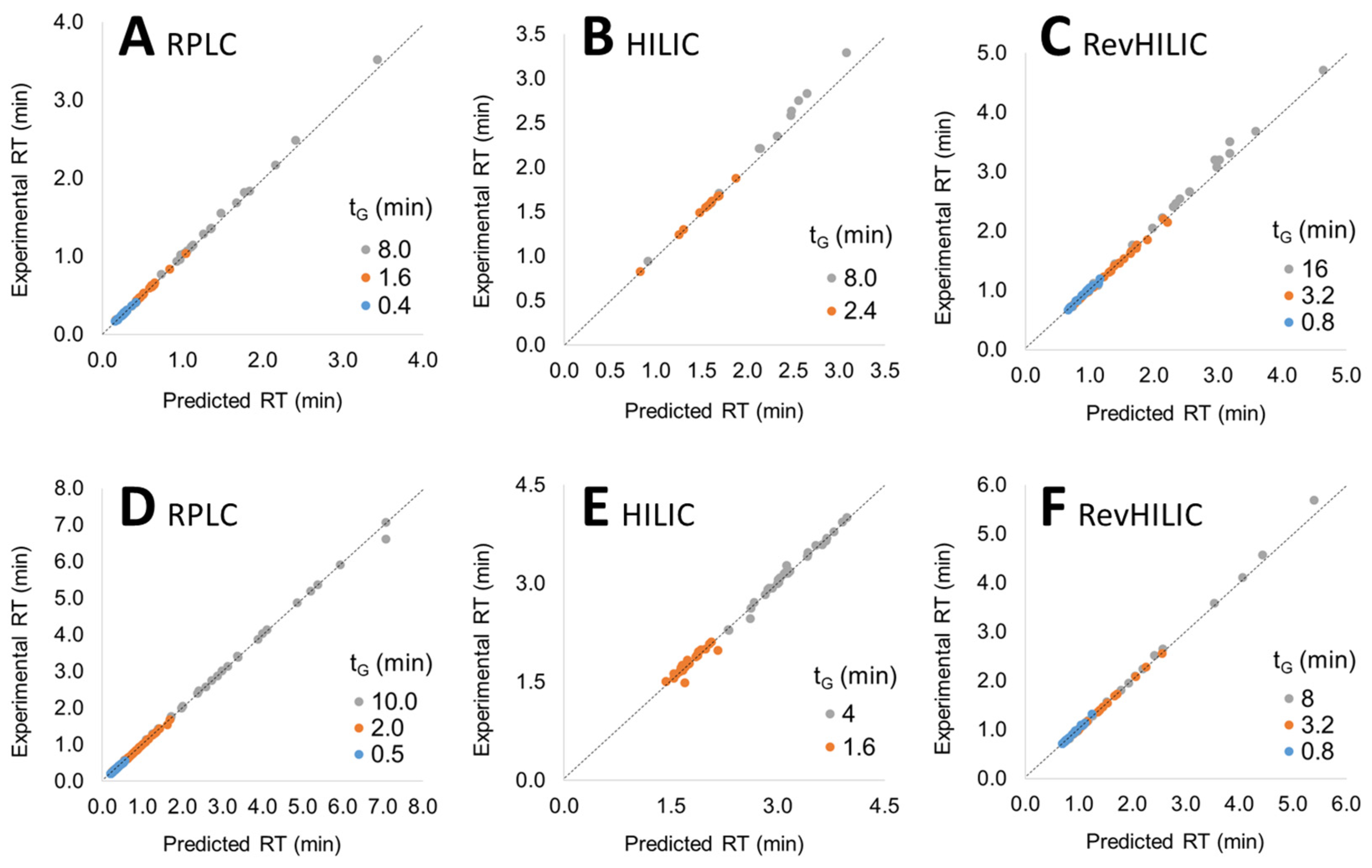

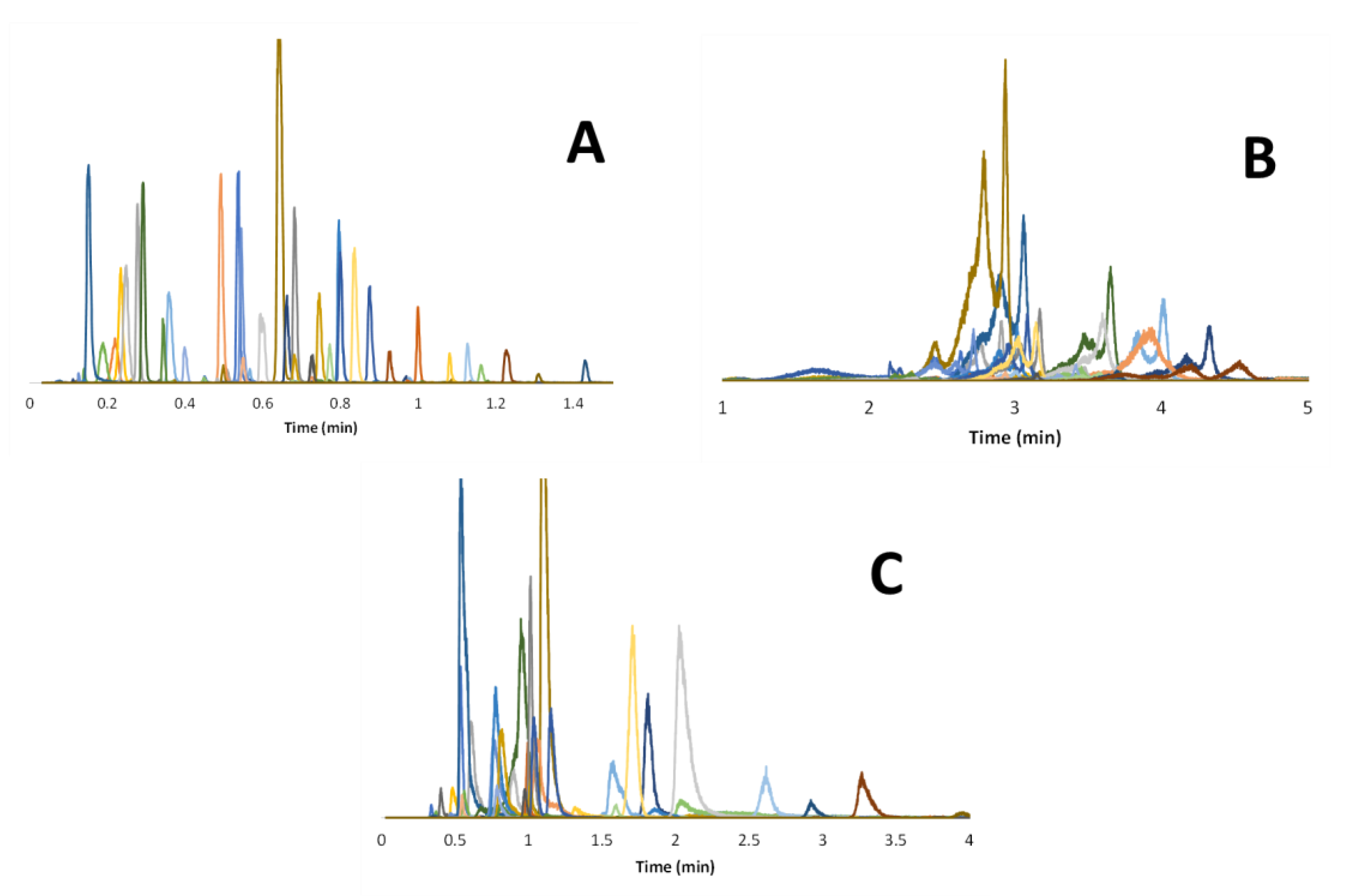
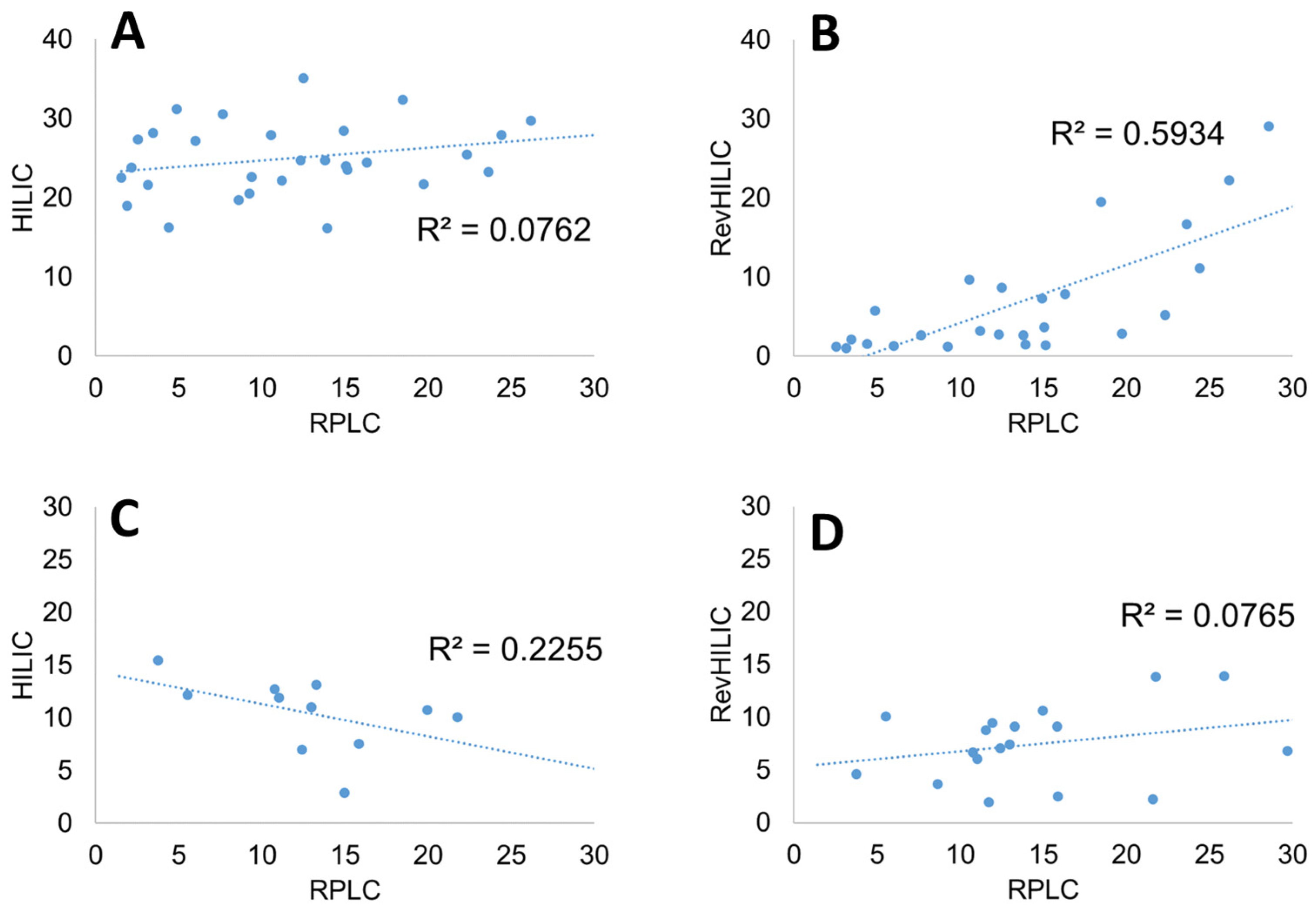


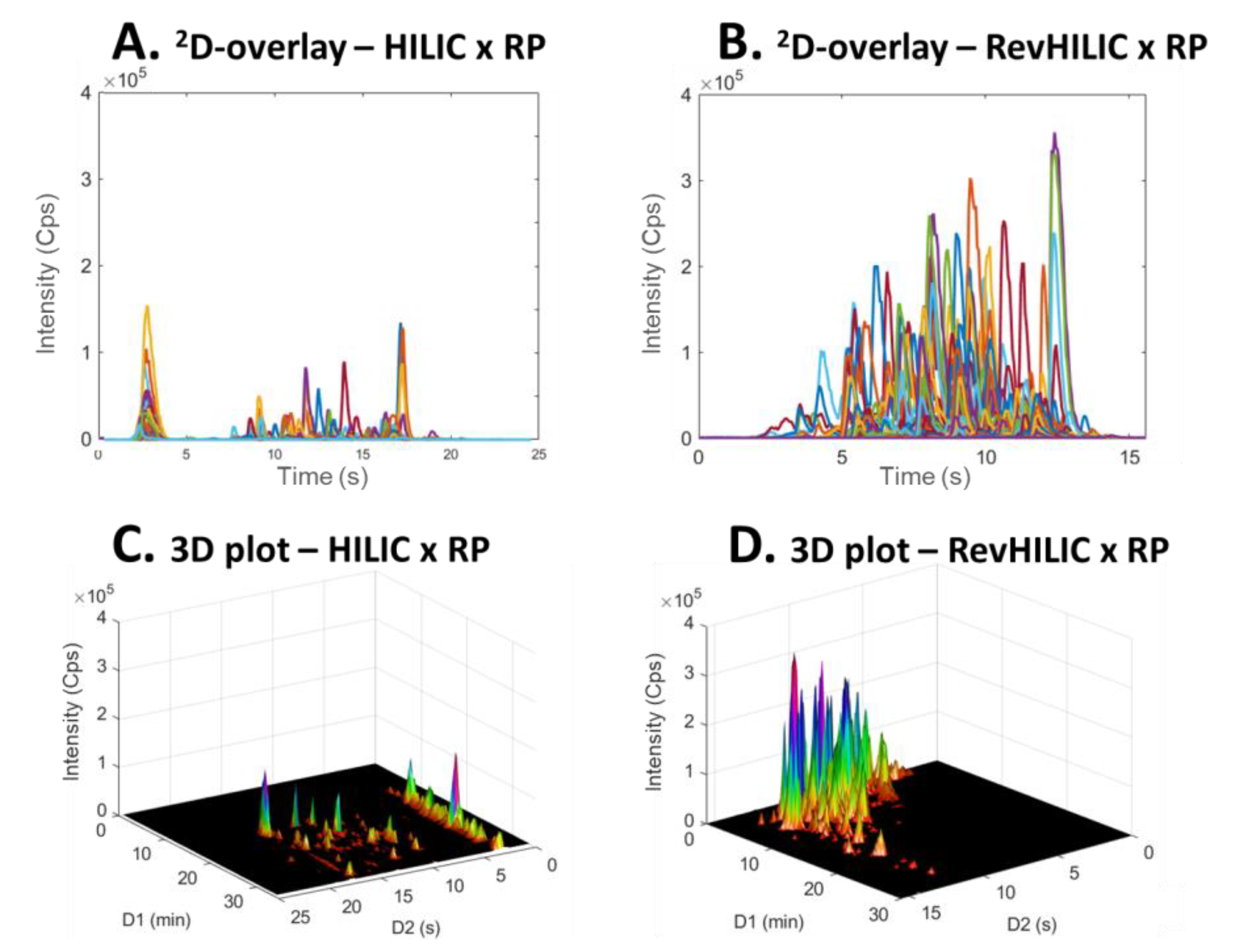
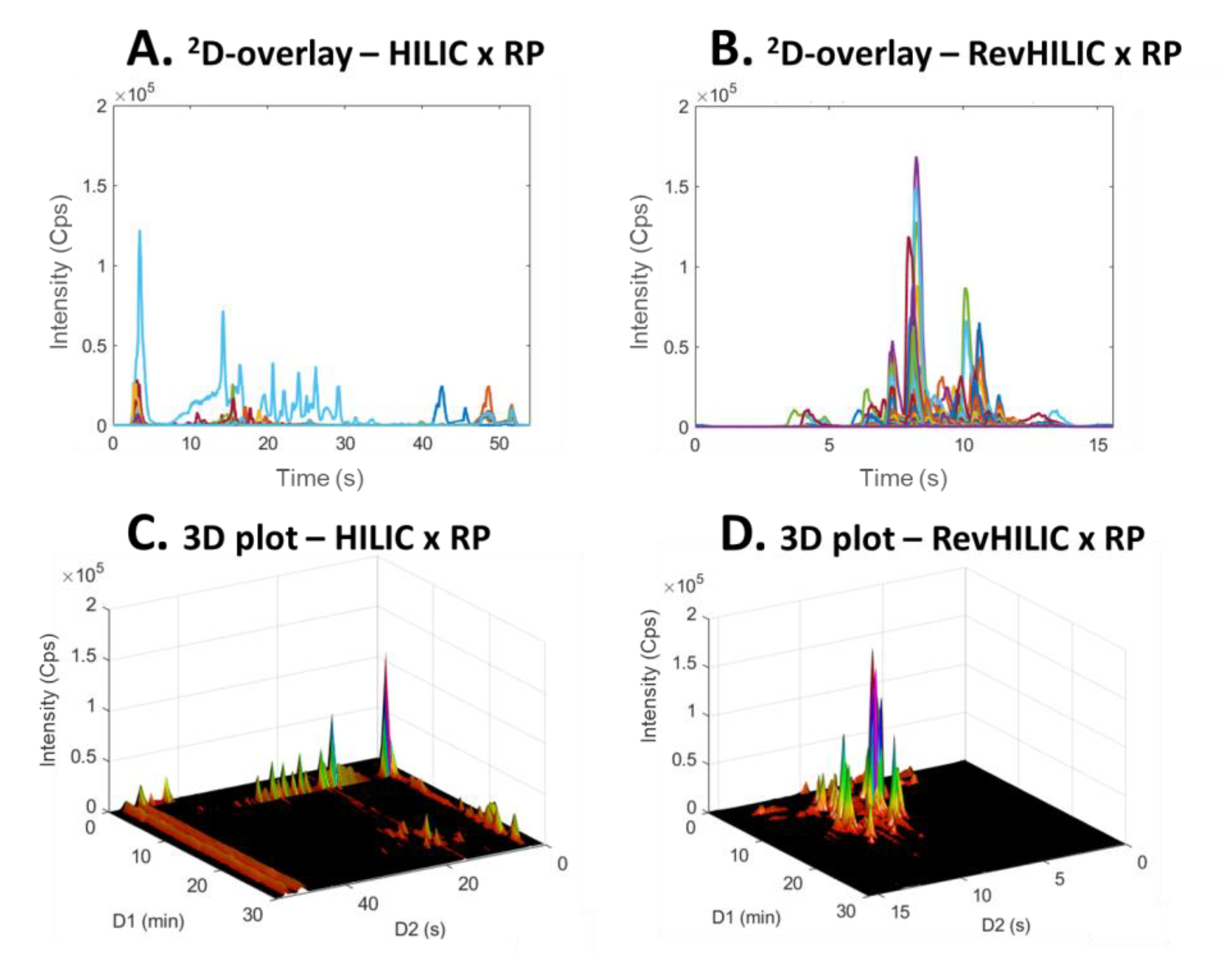
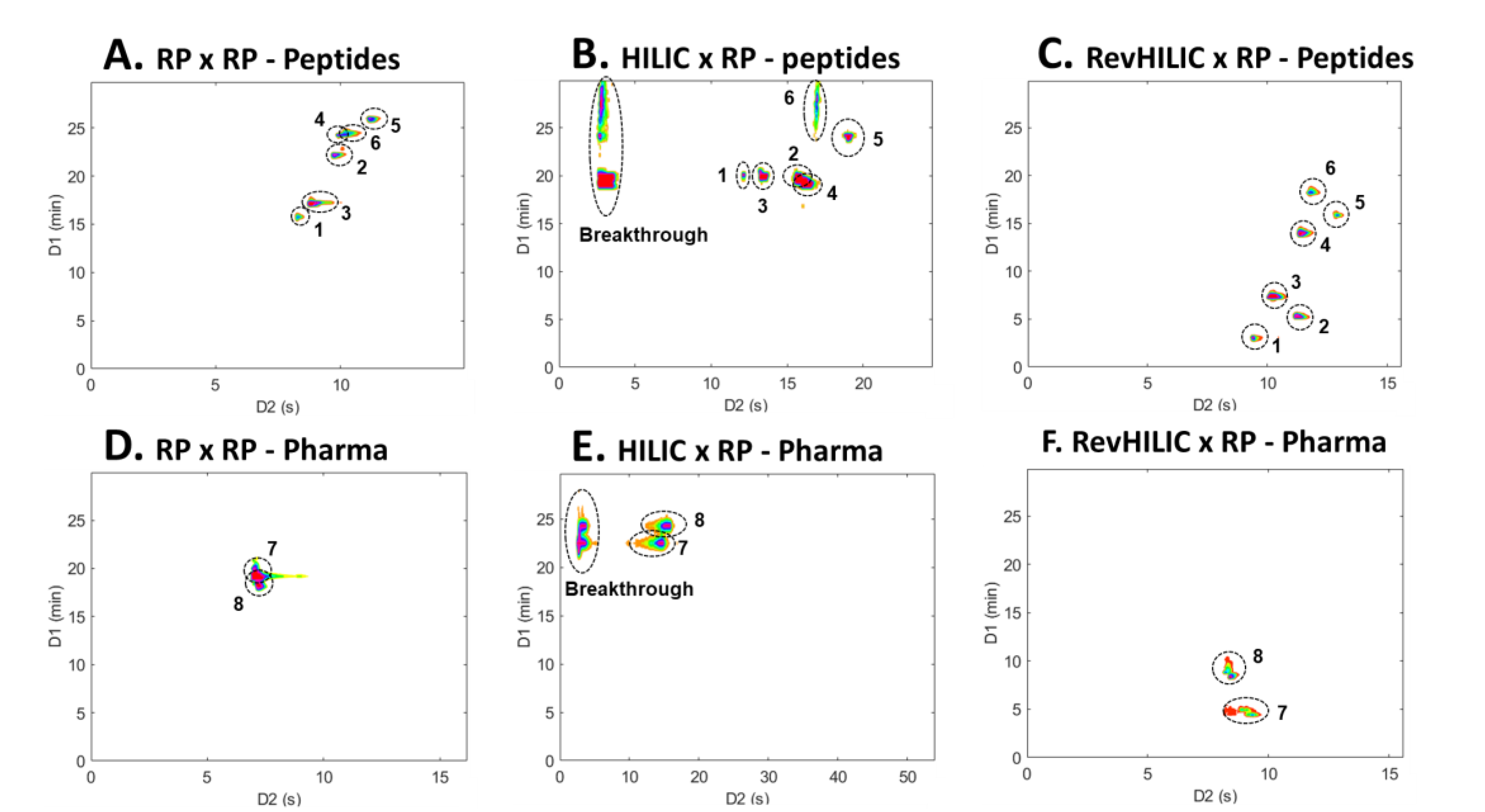
| RPLC × RPLC | HILIC × RPLC | revHILIC × RPLC | |
|---|---|---|---|
| First dimension | |||
| Injection volume | 5.8 µL | 1.8 µL | 3.1 µL |
| Stationary phase | Acquity CSH C18 | Viridis BEH HILIC | Viridis BEH HILIC |
| Column geometry | 30 × 2.1 mm; 1.7 µm | 50 × 2.1 mm; 1.7 µm | 50 × 2.1 mm; 1.7 µm |
| Temperature | 30 °C | 30 °C | 30 °C |
| Mobile phase A | Water + 10 mM AA | Water + 10 mM AA | Water + 10 mM AA |
| Mobile phase B | ACN | ACN | ACN |
| Flow rate | 0.20 mL/min | 0.05 mL/min | 0.14 mL/min |
| Gradient | 1–36% B in 30 min | 10–52% A in 30 min | 1–40% B in 30 min |
| Modulation | |||
| Loop volume | 60 µL | 60 µL | 80 µL |
| Sampling time | 0.25 min | 0.41 min | 0.26 min |
| Second dimension | |||
| Stationary phase | Acquity CSH C18 | Acquity CSH C18 | Acquity CSH C18 |
| Column geometry | 30 × 2.1 mm; 1.7 µm | 30 × 2.1 mm; 1.7 µm | 30 × 2.1 mm; 1.7 µm |
| Temperature | 80 °C | 80 °C | 80 °C |
| Mobile phase A | Water + 0.1% FA | Water + 0.1% FA | Water + 0.1% FA |
| Mobile phase B | ACN + 0.1 % FA | ACN + 0.1 % FA | ACN + 0.1 % FA |
| Flow rate | 2.6 mL/min | 2.6 mL/min | 2.6 mL/min |
| Gradient | 1–45% B in 0.13 min | 1–45% B in 0.33 min | 1–45% B in 0.15 min |
| RPLC × RPLC | HILIC × RPLC | revHILIC × RPLC | |
|---|---|---|---|
| First dimension | |||
| Injection volume | 8.3 µL | 4.5 µL | 5.5 µL |
| Stationary phase | Acquity CSH FP | Viridis BEH HILIC | Viridis BEH HILIC |
| Column geometry | 30 × 2.1 mm; 1.7 µm | 50 × 2.1 mm; 1.7 µm | 50 × 2.1 mm; 1.7 µm |
| Temperature | 30 °C | 30 °C | 30 °C |
| Mobile phase A | Water + 10 mM AA | Water + 10 mM AA | Water + 10 mM AA |
| Mobile phase B | MeOH | ACN | ACN |
| Flow rate | 0.17 mL/min | 0.04 mL/min | 0.17 mL/min |
| Gradient | 1–79% B in 30 min | 2–30% A in 30 min | 1–31% B in 30 min |
| Modulation | |||
| Loop volume | 60 µL | 60 µL | 80 µL |
| Sampling time | 0.27 min | 0.9 min | 0.26 min |
| Second dimension | |||
| Stationary phase | Acquity CSH C18 | Acquity CSH C18 | Acquity CSH C18 |
| Column geometry | 30 × 2.1 mm; 1.7 µm | 30 × 2.1 mm; 1.7 µm | 30 × 2.1 mm; 1.7 µm |
| Temperature | 80 °C | 80 °C | 80 °C |
| Mobile phase A | Water + 0.1% FA | Water + 0.1% FA | Water + 0.1% FA |
| Mobile phase B | ACN + 0.1 % FA | ACN + 0.1 % FA | ACN + 0.1 % FA |
| Flow rate | 2.6 mL/min | 2.6 mL/min | 2.6 mL/min |
| Gradient | 1–99% B in 0.15 min | 1–99% B in 0.78 min | 1–99% B in 0.14 min |
| αa | γb | 1Δt (min) | 2Δt (s) | 1w4σ (min) | 2w4σ (s) | n2D,effec | |
|---|---|---|---|---|---|---|---|
| RPLC × RPLC | 0.25 | 0.51 | 30 | 10.6 | 0.07 | 0.40 | 571 |
| HILIC × RPLC | 0.38 | 0.83 | 25.4 | 15.9 | 0.18 | 0.26 | 971 |
| revHILIC × RPLC | 0.34 | 0.43 | 26.8 | 11.8 | 0.10 | 0.31 | 560 |
| α | γ | 1Δt (min) | 2Δt (s) | 1w4σ (min) | 2w4σ (s) | n2D,effec | |
|---|---|---|---|---|---|---|---|
| RPLC × RPLC | 0.35 | 0.58 | 30 | 12.5 | 0.11 | 0.29 | 886 |
| HILIC × RPLC | 0.48 | 0.56 | 27 | 40 | 0.53 | 0.60 | 341 |
| revHILIC× RPLC | 0.47 | 0.66 | 23.5 | 10.8 | 0.15 | 0.34 | 593 |
Disclaimer/Publisher’s Note: The statements, opinions and data contained in all publications are solely those of the individual author(s) and contributor(s) and not of MDPI and/or the editor(s). MDPI and/or the editor(s) disclaim responsibility for any injury to people or property resulting from any ideas, methods, instructions or products referred to in the content. |
© 2023 by the authors. Licensee MDPI, Basel, Switzerland. This article is an open access article distributed under the terms and conditions of the Creative Commons Attribution (CC BY) license (https://creativecommons.org/licenses/by/4.0/).
Share and Cite
Chapel, S.; Rouvière, F.; Guillarme, D.; Heinisch, S. Reversed HILIC Gradient: A Powerful Strategy for On-Line Comprehensive 2D-LC. Molecules 2023, 28, 3907. https://doi.org/10.3390/molecules28093907
Chapel S, Rouvière F, Guillarme D, Heinisch S. Reversed HILIC Gradient: A Powerful Strategy for On-Line Comprehensive 2D-LC. Molecules. 2023; 28(9):3907. https://doi.org/10.3390/molecules28093907
Chicago/Turabian StyleChapel, Soraya, Florent Rouvière, Davy Guillarme, and Sabine Heinisch. 2023. "Reversed HILIC Gradient: A Powerful Strategy for On-Line Comprehensive 2D-LC" Molecules 28, no. 9: 3907. https://doi.org/10.3390/molecules28093907
APA StyleChapel, S., Rouvière, F., Guillarme, D., & Heinisch, S. (2023). Reversed HILIC Gradient: A Powerful Strategy for On-Line Comprehensive 2D-LC. Molecules, 28(9), 3907. https://doi.org/10.3390/molecules28093907






